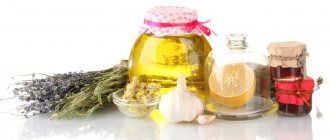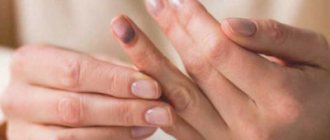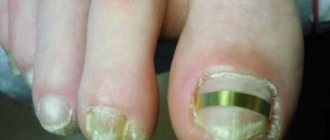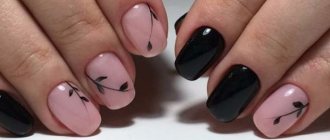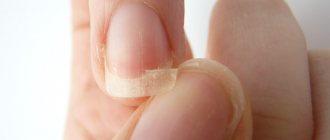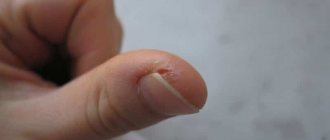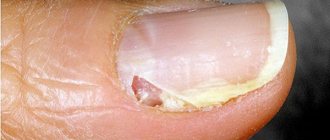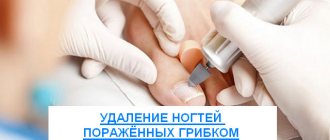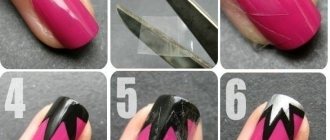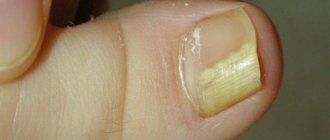Panaritium is an inflammatory process that can occur both deep inside the tissues and closer to the surface of the fingers and toes. If measures are not taken in time to remove or treat the panaritium, the abscess will increase in size and a serious infection will develop.
Painful sensations, development of the inflammatory process and further accumulation of pus under the skin or nails on the phalanges of the fingers and toes are called panaritium.
Typically, an abscess forms in close proximity to the nail plate and causes a lot of inconvenience to the patient.
IMPORTANT: A feature of periungual felon is its ability to quickly spread deep into tissues in the absence of proper treatment.
Finger felon
Finger felon, symptoms
For all types of felon there are several common symptoms.
In adults and children, the disease develops in the same way; its main symptoms are:
- pulsation, pain and discomfort in the affected area
- increased pulsation and pain when lowering the patient
- limbs and relief of its condition when lifted
- tumor, edema
- redness of the skin around the site of infection
- restriction of movement of the injured finger
IMPORTANT: Increased pulsation and pain, the appearance of cyanosis indicate a worsening situation.
Swelling, redness and formation of pus - symptoms of panaritium
Types of felon
Depending on the location of the inflammation, several types of panaritium are distinguished:
- Skin – the skin is affected, the pain is insignificant, tolerable, but progressive and increasing. Characterized by redness of the skin and the formation of a vesicle filled with pus.
- Subcutaneous – inflammation of the subcutaneous fat layer. It manifests itself as a feeling of excessive “tightness” of the skin, pulsation, swelling, deterioration of the general condition and, in some cases, an increase in temperature. Symptoms appear 5–7 days after injury
- Tendon - occurs as a result of complications of cutaneous or subcutaneous panaritium, or a deep wound. A few hours after injury, patients notice throbbing pain, the appearance and intensification of swelling. The finger turns red and independently takes a semi-bent position; when straightened, severe pain is felt. If the necessary medical care is not provided, the condition worsens, the temperature rises, and headaches appear.
- Articular - purulent damage to the joint due to infection entering deep into the tissues from the outside (with deep penetrating injuries) or in the event of a complication arising from cutaneous, subcutaneous or tendon panaritium. It is characterized by severe pain, swelling, and redness of the entire finger. There may be involuntary, unnatural movements of the finger. If the inflammation has affected the ligaments, a crunching sound will be heard when bending and straightening the injured finger. Over time, the pain will intensify, nausea, vomiting, darkening of the eyes, and fever may occur.
- Bone – rarely develops initially. Basically it is a complicated form of another, lighter type of panaritium. Symptoms in the form of pain and swelling of the finger appear 3–10 days after infection. Over time, the periungual part of the finger “swells” and a so-called fistula appears. Signs of intoxication appear: headache, nausea, vomiting, weakness, rapid heartbeat, darkening of the eyes, loss of consciousness
If we talk about felon that touched the nail plate, then it can be of two types:
- subungual – happens when a splinter gets under the nail or due to nail biting. The pus is located directly under the nail plate and can be seen through it. The pain is throbbing, the finger turns red. After a few days the pus breaks out. In this case, the nail plate may peel off
- periungual (paronychia) - can develop due to poor quality deburring, splinters or other mechanical damage to the periungual fold. If the paronychia is deep, the nail plate and periungual fold are affected, but if the periungual panaritium occurs in a mild form, the nail remains intact - suppuration forms only on the skin. In the first case, deep layers may become infected and complications may develop. Periungual panaritium is characterized by: pain, redness, formation of visually visible subcutaneous blisters with pus
Periungual felon
Rules for using the solution
The treatment procedure is quite simple, but has its own characteristics. To treat purulent wounds, salt baths can also be used for washing, but salt dressings are mainly applied for therapeutic purposes.
In addition to the correct concentration of the solution, several more rules should be followed for the most effective treatment with saline solution:
- To apply dressings soaked in salt solution, you should use only natural cotton, linen without any pattern or dyeing, or ordinary gauze folded in several layers. An important point is good air permeability in the applied bandage, as well as the absorbency of the fabric used.
- The applied bandage must be open . Under no circumstances should you wrap or cover it with cellophane, since air must circulate freely inside the impregnated fabric.
- Before applying such a compress, the skin at the treatment site should be thoroughly washed with laundry soap or treated with an antiseptic (depending on the type of wound) and dried with napkins.
- To apply a bandage, the prepared clean cloth must be folded in several layers according to the size of the area in need of treatment, then soak it in the solution, squeeze it lightly so that there are no drips, and apply it to the sore spot or wound. The level of humidity should be medium, since a cloth that is too wet will create discomfort, and a bandage that is too dry will not bring the expected benefit.
- This bandage should be secured with a bandage, a piece of dry gauze or pieces of adhesive tape along the edges of the attached fabric. You cannot insulate the compress in any way, for example, by wrapping it in woolen cloth.
If there are no contraindications to the use of the solution, then the bandage is applied for 10 or 12 hours, but the treatment time can be individual, depending on the type of wound, the degree of existing damage, and the presence of complications. You can apply bandages twice a day or change them as the fabric dries.
After removing the salt bandage, the skin should be wiped with a soft cloth soaked in a decoction of chamomile or calendula. If the skin is intact, you can simply rinse the treatment area with warm water, but in the case of an open wound, you should not pour water onto the injury site.
Reasons for felon
The development of nail panaritium occurs when the actions of several factors coincide. One cut or splinter will not cause serious damage.
So, first of all, at least damage to the skin must occur:
- burn
- a cut
- injection (puncture)
- scratch
Most often, such wounds are caused by:
- wood (splinters)
- metal shavings
- manicure tools
- bone fragments from cutting meat or fish
- sewing supplies (needles, pins, etc.)
Splinter is one of the reasons for the development of felon
When the integrity of the skin is damaged, staphylococcus (streptococcus, E. coli or other microorganisms ) penetrates into the wound.
Usually such microtraumas are not paid attention to and are not treated. Without proper treatment, the infection remains and begins to develop rapidly, infecting nearby tissues.
Favorable factors for the development of felon are:
- hand contamination
- frequent moisturizing of the skin (when washing dishes, floors, laundry)
- interaction with chemically active substances (powders, detergents and cleaners)
IMPORTANT: Weakened immunity also contributes to the formation of felon.
Dirty hands contribute to the appearance of felon
An abscess on a finger near the nail in a newborn or infant: causes, treatment
The main reasons for the appearance of abscesses near the nails of infants are:
- injuries caused by scissors while trimming nails
- burr formation
- trying to cut out an ingrown toenail
- ingrowth
If you notice redness of a finger or toe in your baby, the best thing to do is contact a pediatric surgeon. The specialist will examine the damage and, depending on the situation, determine the optimal treatment.
IMPORTANT: In a child’s body, all processes occur very quickly. Therefore, in the shortest possible time, even the smallest untreated scratch can cause a huge abscess to appear on your finger.
If the case is advanced, the doctor will prescribe antibiotics. In the initial stages, it is possible to treat felon with ointments, salt baths, herbal infusions and treatment with antiseptics.
IMPORTANT: Do not open the abscess yourself. This can only complicate the situation.
Panaritium in a baby
How to treat an abscess on a finger or toe
With paronychia, an infected person feels throbbing pain at the site of the pathology, the skin becomes reddish and swells. The swelling area begins to fester, and without treatment, the pain becomes very severe and the temperature rises. Doctors know how to properly treat an abscess on a finger near the nail, so when alarming symptoms arise, the patient should urgently contact a medical facility for help.
Conservative treatment
At the initial stages, you can treat the abscess yourself. If a finger or toe breaks with mild pain, baths with a solution of potassium permanganate (weak), anti-inflammatory ointments and compresses with them will help. After treatment with manganese, you should apply one of the selected antibacterial drugs to the bandage, apply it to the inflamed area, bandage it and leave it on for a day. The best ointment for abscesses on the finger is Vishnevsky. The drugs Levomekol, Gentaxan, and Dioxin ointment quickly remove suppuration.
If the pain becomes frequent and throbbing, and the abscess becomes large, then paronychia cannot be cured at home - you need to go to a surgeon. After diagnosis, the doctor usually prescribes the following medications:
- Nonsteroidal tablets Nimesil, Diclofenac, Ibuprofen. They stop the inflammatory process.
- Ichthyol ointment. It reduces redness, draws out suppuration and swelling. Apply to the affected area.
- Antifungal drugs Lamisil, Orungal. Prescribed if the disease is accompanied by a fungal infection.
- Antibiotics Metronidazole, Clindamycin. They destroy the pathogen and improve the patient’s well-being.
Folk remedies and herbs
Our ancestors also knew how to treat an abscess on a finger near the nail. If a periungual cut, hangnail or callus has festered, use the following procedures:
- Baked onion. Bake the onion directly in the skins in the oven until soft. Cut out the middle so as not to damage its integrity. Place the ball with the hole on the finger with the abscess and secure it with a plaster or bandage. Keep the compress for 3 hours, repeat the procedure if necessary.
- Baby soap. If your toe near the nail, for example, your little finger, is red and sore, thoroughly lather a cotton pad with baby soap, apply it to the area of the abscess overnight, and secure it with an adhesive plaster. Compresses are made until no trace remains of redness and pus.
- Herb St. John's wort. When the finger is swollen and festered, make an infusion of St. John's wort to draw out the pus. To do this, pour a glass of boiled water over a tablespoon (tablespoon) of dry herbs, then let it brew for half an hour in a warm place. After cooling, blot gauze or bandage with St. John's wort infusion, apply a compress to your finger, and fix for 20 minutes. The procedure is performed several times a day until recovery.
- Kerosene. How to treat an abscess on a finger near the nail with a flammable mixture? Very fast and easy! Dip the finger with the abscess in purified kerosene for a couple of minutes. The substance disinfects tissues and promotes rapid recovery.
- Amount of fine for registration in passport
- The Public Chamber proposes to pay pensioners 15 thousand rubles
- DIY modular paintings
Surgical intervention
In the absence of positive dynamics after conservative treatment, the surgeon may suggest removing the pus from the finger through surgery. The procedure is simple and is done under local anesthesia. You can see how the operation is performed on the Internet using photos and videos. Brief description of the surgical intervention:
- after anesthesia, an incision is made over the abscess;
- purulent discharge and dead tissue are removed;
- if the patient has subungual panaritium, then the nail is removed;
- local antibiotics are administered;
- a patch is applied;
- after that, the patient is given new dressings daily with wound-healing medications;
- the postoperative period lasts one week.
Panaritium on a finger near a child’s nail, reasons
It would seem that there was no damage; the child does not remember where or how he received the wound. However, a panaritium appeared on the finger near the nail. Why did this happen?
There may be several reasons:
- mechanical damage during the game (pricks, cuts, bruised nails, etc.)
- animal scratches
- ingrown nails, infection when cutting and
- nail biting
- wearing tight shoes
IMPORTANT: Panaritium often occurs in children suffering from fungal nail diseases.
Regardless of whether you were able to determine the cause of felon in your child, be sure to consult a doctor.
Panaritium on a child's finger after biting his nails
What to do if a child’s finger breaks out
Often children try to tear off a hangnail on their finger, after which suppuration almost always occurs. How to treat an abscess on a child’s finger near a nail? You can help your baby even before the doctor arrives with a warm bath with sea salt. Place sea (table) salt in warm water, add a couple of drops of iodine and keep the child’s finger in the solution for 5 minutes, do this 5-6 times a day. Baths with brewed herbal infusions, which include chamomile, plantain, and sage, also help to alleviate the condition.
Causes of an abscess on the finger near the fingernail
Staphylococcal infection, which statistically affects every third person, penetrates the wound and quickly forms an abscess. It is staphylococcus that is most often the “culprit” for the formation of abscesses on the fingers near the nail.
However, the risk of developing felon also increases in carriers of the herpes virus and fungal diseases.
In the first case, so-called herpetic felons , outwardly easily distinguishable from ordinary purulent formations. The peculiarity of herpetic felon is that it can “dormant” for several months. That is, from the moment of infection to the appearance of purulent formations on the finger, a lot of time will pass.
IMPORTANT: Under no circumstances should you open herpetic abscesses. This infection is very contagious and, after breaking out, can quickly spread to adjacent areas of the skin.
Damage from manicure instruments is one of the causes of panaritium on the hands
Why does my finger itch?
Periungual panaritium is a purulent inflammatory process under the nail. The causative agent is pathogenic microflora (staphylococci or streptococci). Suppuration of the skin near the nail is the main symptom of felon. There are several reasons why such an abscess appears.
- Accumulation of bacteria under the nail rim.
- The keratinized dermis through which water and nutrients do not penetrate.
- Micro injuries, skin damage. One of the likely reasons is an unsuccessful manicure or pedicure, during which the cuticle was opened.
- Ingrown nail.
- Wearing tight shoes, excessive sweating (toes).
- “Dirty” work without protective gloves.
- Nail biting.
- Splinters. Any foreign objects can cause a purulent inflammatory process.
ATTENTION! All wounds on the hands and feet must be promptly treated with an antiseptic. Pathogens can enter the body even through small cracks in the skin. As a result, the onset of dangerous purulent inflammation.
Rice. 1 – Abscess on the leg
Toe felon treatment
Panaritium can affect the toes in cases of mechanical damage to the skin (puncture), burns, trauma, or when wearing tight, uncomfortable shoes.
IMPORTANT: The course of the inflammatory process on the fingers and toes is the same, however, if an abscess on the finger causes inconvenience only when moving the injured limb, then an abscess on the toe makes it impossible or very painful to put on shoes and move.
If the panaritium of the finger is in a neglected state and the infection has penetrated deeply, affecting nearby tissues, only prompt surgical intervention will help.
When the panaritium of the finger has just announced itself with discomfort, redness and swelling, you can try to correct the situation yourself:
- Identify the factor that provoked the inflammation and eliminate its further effect
- Carefully treat the sore finger with alcohol or other disinfectant
- Then soak your finger in a strong, hot saline solution for 15-20 minutes (repeat 3-4 times a day)
- At night, apply a bandage with ichthyol ointment.
- Continue for 3 – 4 days
- If treatment does not help, and felon continues to “gain strength”, do not delay visiting a doctor
Panaritium of the toe
Causes
Provoking factors:
- onychomycosis – fungus on the feet and nails;
- violation of venous circulation;
- ingrown nail;
- improper manicure/pedicure;
- cuts, abrasions in the area of the nail fold, near the nail and fingertip;
- diabetes.
Note! Often, abscesses on the fingers occur in people engaged in manual labor. While performing professional duties, it is easy to get hurt, get a splinter, scratch your finger, prick yourself with a fish bone, and so on. Dirt, dust, technical oils will complete the “dirty deed.”
An abscess on the toe appears:
- after an impact, injury to the skin with further penetration of dirt;
- as a consequence of an incorrectly performed pedicure when infection penetrates into wounds, cuts, under unprotected skin next to the nail plate;
- When wearing tight, uncomfortable shoes, not only an ingrown toenail can appear, but also an abscess if the integrity of the skin is compromised.
Treatment of felon at home on the arm and leg using folk remedies
Several simple recipes, according to adherents of traditional treatment, can get rid of panaritium at home without the use of medications or visiting a doctor.
Recipe No. 1. Boil 2 tbsp. water, pour 2 tbsp into it. sea salt. In the absence of sea salt, it is permissible to use table salt. Make sure the salt is completely dissolved in the water. While the saline solution is still hot, dip your injured finger into it and hold for 15-20 minutes. Do not wipe or rinse your finger. Repeat 3 - 4 times a day. You can add 1 tbsp to this saline solution. soda If the remedy works, after a while the finger will begin to “twitch”. Sea water also helps heal various abscesses, skin inflammations and rashes.
Recipe No. 2. When a formed abscess appears, use ordinary laundry soap. Wet your finger and lather the affected area vigorously. Without rinsing, bandage. After an hour, you will feel your finger at the site of the abscess begin to tug and tug. Then the abscess will burst.
Laundry soap for treating felon
Recipe No. 3. Bandage an aloe leaf, cut in half lengthwise, to the sore spot overnight. The next morning the leaf will be completely dry - don’t be surprised by this. Repeat the procedure every time you go to bed until the treatment is completely healed.
Recipe No. 4. Bake half a medium-sized onion in a dry frying pan. While the onion is still hot, bandage it to the affected area so that the cut touches the inflamed area or fistula. Overnight the onion will draw out the pus. Repeat the procedure until recovery.
Recipe No. 5. Baths with potassium permanganate will help relieve inflammation. Dissolve several crystals of potassium permanganate in warm water until it turns pink. Keep the sore finger in the solution for 7 - 10 minutes. You can add 1-2 drops of calendula alcohol tincture to such baths.
Baths with potassium permanganate for the treatment of felon
IMPORTANT: If the chosen treatment option does not provide relief, do not continue experimenting, but consult a doctor as soon as possible. The disease progresses so quickly that even one lost day can play a role and lead to serious complications. Once the inflammation affects the bone, there will be no chance to save the finger - it will have to be amputated.
Prevention of inflammatory processes on the hand near the nail plate
To prevent such a minor, but very unpleasant inflammation of the cuticle and finger, it is enough to follow simple preventive measures:
- Constant adherence to hygiene rules. Hangnails on and around the nails should not be picked off or bitten off. If the cuticle is still damaged, do not forget to treat the wound with an antiseptic.
- If you have problematic, dry skin or have worked with household chemicals, do not forget to take care of your skin. Use softening creams.
- When performing various tasks around the house or in the garden, protect your hands with special household gloves.
- Get your manicure done only by professional nail technicians who process the tool in a timely manner. If you take care of your nails yourself, also do not forget to sterilize all instruments in a timely manner, do not rely on chance, consult with the masters on how they sterilize their instruments.
Reference. In order for your cuticle to always be healthy and well-groomed, when performing a manicure you need to remove not all of it, but only dead cells.
An overgrown cuticle can cause many problems for your beauty. It changes the shape of the nails and stripes appear on the nails. There are several ways to remove dead cuticles.
Classic way
Here the cuticle is trimmed with manicure tools - various scissors and tweezers:
- During this procedure, the hands are treated with a disinfectant, then the nails are shaped. This must be done before soaking, so as not to damage the nail when filing and to avoid delamination.
- Then a bath with warm water is prepared. You can add medicinal salt, herbal decoction or softening gel to the water. For fragrance, add a few drops of your favorite aromatic essential oils. You need to hold your hands in this bath for about seven minutes.
- After that, do not forget to remove the remaining polish or gel polish from the nails.
- After which the cuticle is removed with tweezers or scissors. This is a very important part of the procedure, so you should not save on tools by buying the lowest quality and cheapest; preference should be given to stainless steel tools with manual sharpening of the cutting surface.
- Next, very carefully push the cuticle with a pusher tool from the edge of the nail to its middle.
- We use a special file to clean the pterygium (this is what manicurists call the barely visible layer of cuticle on the nail plate). Be careful not to scratch your nail when performing these operations.
- Then trim off the keratinized pieces of skin around the nail, try to remove the cuticle in one piece, then you won’t get hangnails.
- At the end of the procedure, apply nail care cream or oil to the cuticles.
The undoubted advantage of this method is the ability to get well-groomed nails in the shortest possible time. The disadvantages are that more cuticles are removed than necessary, which can increase the risk of infection, and after the procedure itself, the cuticle grows more quickly, becomes tougher and creates problems with further removal.
The following video shows all the stages of a classic manicure:
No trim manicure
In general, it is similar to the classic method of removing cuticles, with the only difference that instead of tweezers or scissors, chemicals based on alkali or acids are used to remove it. They are also called “keratolics”. Keratolytics help soften the cuticle, after which it is moved using a special “orange stick”.
Since the fingers are not first steamed in a bath,
a trimless manicure can also be called “dry”. This manicure ends in the same way as a classic one, by applying care products to the nail plate and finger.
There are many more advantages to this method, the safety for the health of the finger is much higher, the skin is not injured and, most importantly, only dead parts of the cuticle are removed!
Important! However, it is difficult to immediately switch to a trimless manicure from a classic one; several intermediate procedures will be required to prepare the cuticle.
The video below shows how an unedged manicure is done:
Brazilian
It is also a branch of the classic manicure with the difference that a nail file is used instead of cutting tweezers or scissors. And to moisturize the skin, use special moistened gloves soaked in a fortified composition. These gloves are used to massage the fingers, then a softening cream is rubbed in with them, and then the cuticle is pushed back with a special stick and treated with a nail file.
This method is good because it eliminates the risk of infection, the skin is not injured, and thanks to the fortified impregnation of the gloves, the skin is saturated with useful minerals and vitamins. They mainly remove keratinized areas of the cuticle and skin, preserving the living ones. Well, during the procedure it smells pleasantly of herbs and fruits. And you don’t have to use an expensive tool.
Among the disadvantages is that such a Brazilian manicure will not help in particularly difficult situations and neglect, and to carry it out you need to buy special kits.
All stages of Brazilian manicure can be seen in the video:
Hardware
An increasingly popular type of nail and cuticle care.
The method is high-tech, which does not require pre-softening and preparing the skin; only dead cells are removed, while living ones continue to protect the nail. However, this manicure is inconvenient because it cannot be done at home; it is done only in special nail salons.
All the nuances of this procedure are shown in the video:
Solar
Attention! One of the most fashionable and latest innovations. This method is very useful for the cuticle itself, and it can be done at home.
For this purpose, a special preparation is purchased, which contains various salts and oils from the Dead Sea and its surrounding areas. The role of peeling is performed by medicinal salts, and the oil prepares and moisturizes the skin.
- To carry out a solar manicure, first the hands are disinfected, then the drug is applied and a massage is performed with dry hands and then with wet ones. The salts of the drug, under the influence of moisture, penetrate deep into the skin, and a soft peeling is obtained. During this procedure, dead skin cells and cuticles are exfoliated, the pores on the skin open wider, and the oil of the drug penetrates very deeply into the skin.
- Then, for the “sauna effect,” a plastic bag or plastic gloves are put on your hands.
- After about twenty minutes they are removed and the hands are massaged again. In this case, a cream with oils from the Dead Sea is also used. Due to this combined and healing effect, the skin of the fingers is moisturized very deeply, it turns out smooth and very elastic.
Beautiful, well-groomed and healthy fingers and nails say a lot about their owner. Don’t forget to follow simple rules of prevention, and then soft, smooth and healthy fingers will thank you and save you from further hassle with treating inflammation. Remember that even the best manicurist will not be able to make your fingers attractive if you do not take care of your cuticles yourself.
Antibiotics for finger felon
“Antibiotics are needed” is a decision sometimes made by doctors after assessing the condition of the injured finger. There is no need to argue. Antibacterial therapy in such cases is the only salvation from the development of complications and relief from the inflammatory process.
IMPORTANT: If the doctor prescribes antibiotics for the treatment of felon, it means that the inflammation has already affected the tendons or joints, or there is a high probability of their damage. In addition to antibiotic treatment, surgical intervention is often necessary.
Amoxiclav, ciprofloxacin or levofloxacin are often prescribed for the treatment of panaritium If the pathogen turns out to be resistant to this group, the prescription is changed.
IMPORTANT: The antibiotic can be prescribed for oral administration, in the form of injections (intramuscular) and locally.
Antibiotic for felon
Dimexide for felon
demexide solution is used to treat felon . This antiseptic effectively fights inflammation.
Moisten a cotton pad or swab generously with the demexide solution. Apply to the damaged finger for 30 - 40 minutes, then remove, but do not rinse or wipe the finger. Repeat until noticeable improvements appear.
IMPORTANT: If adverse reactions occur or there is no effect, the drug is discontinued.
Dimexide for felon
Treatment of abscesses, boils, pimples, fistulas and ulcers with salt
Treatment of abscesses with saline solution
Boils should be washed with hot salt water. The medicinal solution is prepared from 8 g of salt and a glass of water.
Treatment of abscesses, fistulas, ulcers using a salt dressing
Abscesses, fistulas, and ulcers can be treated with a bandage soaked in salt water. The solution in which a soft canvas rag or multi-layer bandage is soaked is prepared according to a ratio of 1:10. The bandage is applied overnight. Treatment is continued until the skin condition improves.
Treating a nail abscess with bread and salt (healers' recipe)
A nail abscess can be cured with black bread soaked in salt water. Prepare a solution of 15–25 g of table salt per 250 ml of water. In the villages they often do it much simpler: they salt the bread, then chew it thoroughly, then apply the chewed bread to the nail abscess and tie the finger with a thick canvas rag. Such a compress, made at night, will draw out the pus by the morning, and the abscess will resolve.
Treatment of nail hangnails
Inflamed nail hangnails are treated with hot salt baths for the hands. To prepare the bath, you need to dilute 50–80 g of salt in two liters of hot water. First, you need to carefully trim your nails and remove hangnails, after which you need to place the fingers on which they formed for 18–20 minutes in a hot solution. The baths last as long as possible until the inflammation goes away and the hangnails disappear.
Treatment of abscesses, boils, boils with salt and honey (healer's recipe)
To treat abscesses, boils, boils, you can use the recipe of the Siberian healer Dmitry Laptev. Mix chicken yolk with 3 g of table salt and 25 g of bee honey. Flour is added to the mixture (after mixing thoroughly) to form a dough. It is placed on the painful area at night (the dough is covered with a medical napkin and not too tightly tied with a canvas rag or bandage).
If the boil is just ripening, then you need to sprinkle fine salt on the area that has begun to become inflamed. Then, using a cotton swab moistened with cologne, you need to carefully rub the salt into the area of inflammation. After this, the treated area cannot be wiped for 20 minutes. If the affected area is treated on time, the inflammation will go away after a certain time, and the boil will not appear.
How to remove warts from hands using saline solution (healer's recipe)
This rustic recipe is called the "wash in a bag" method. You need to prepare a linen bag (you can also take a cotton one). 3 kg of coarse salt is poured into it. Next, they place the hands affected by the warts into a bag and begin to “wash” them with salt. 5–6 such procedures are carried out. It's better to do this at night. This “washing” should take no more than 4–5 minutes. It is necessary to take into account that after some time small blisters may appear on the hands, the skin in some places will gradually come off, and in its place a new one, free of warts, will appear.
How to get rid of dead skin using a saline solution with cream (healer's recipe)
To quickly and effectively get rid of dead skin, for example on the heels, village healers advise using salt with the addition of liquid cream. To prepare a healer's potion, you need to take 20 g of liquid cream, 25 g of salt (preferably sea salt), mix everything well. Rub the resulting lotion in a circular motion into the keratinized areas of the skin (clockwise), hold for 5 minutes, then rinse with water. If the result is not completely satisfactory, then immediately after rinsing the skin, treat it with pumice.
How to get rid of freckles with salt solution (healer's recipe)
You can remove freckles using an aqueous saline solution (to reduce the irritating effect of chlorine on the skin of the face, it is recommended to use sea salt rather than table salt). The cleansing procedure is carried out for 4 days in a row, washing with warm salt water twice (morning and evening). For 200 g of water take 5-6 g of salt.
How to get rid of pustules and juvenile acne with salt
Youthful acne and pustules can be reduced with the help of salt gruel. Sea salt is better suited for preparing a medicinal potion. Preparing the gruel is quite simple: you need to take the required amount of salt and pour in enough water to get the desired consistency. After this, the salt preparation is applied to the affected skin. The procedure is performed using a tampon in a circular motion (clockwise) so that the salt is rubbed into the skin. Keep the salt paste for at least 10 minutes, then rinse with warm water so that the salt remains in the skin pores. It is better to carry out the first procedure in the morning, after 5 hours it should be repeated, and after another 5 hours (in the evening) the salt treatment should be done again. And you can do this for 3 days in a row.
Strengthened antiseptic solution of salt and iodine
To get rid of closed and open small purulent wounds, festering and extremely inflamed boils, festering burns, use an enhanced antiseptic solution. It is prepared with raw water - 8 g of salt per glass. Then the solution is boiled, after which alcohol tincture of iodine (5 drops) is added to it. A sterile bandage folded in four is soaked in this medicinal solution, applied to the abscess, covered with a medical napkin, and bandaged on top with a regular bandage. This procedure is best done at night.
Salt against splitting and brittle nails
If there is a metabolic disorder in the body, in particular the water-salt balance, the fingernails may begin to separate, and longitudinal wavy stripes may form on the nail plates. To get rid of these manifestations, you can use hot baths with a solution of sea salt (1:10). The procedure takes 15–20 minutes.
For brittle nails, prepare the above saline solution. At the same time, a second bath is prepared, into which mineral water is poured, for example, “Essentuki” (500–700 ml). It is cooled in the refrigerator. As soon as both baths are ready, first lower the fingers with sore nails into the hot bath, keep them there for half a minute (no more), and then lower them into cold water for half a minute. This should be done 3-4 times. Finish the treatment procedure with a cold bath.
Treatment of fungal diseases of the feet with salt and soda
Fungal infections usually require antibiotic intervention, but if the feet or spaces between the toes are affected, a saline solution with soda can sometimes be used. To prepare it, dissolve sea salt and baking soda (50 g each) in a liter of water. Keep feet affected by fungus in this solution (25–30 minutes). After the bath, dry your feet without wiping them.
Complications of felon
You can talk as much as you like about the importance of timely medical treatment of felon under the supervision of a specialist, but there will still be those who consider the disease unworthy of attention and, at best, will just treat their finger with an antiseptic from the home medicine cabinet.
Therefore, we note the four most terrible (but probable) scenarios for the development of events with untreated panaritium:
- damage to the tendon , which will permanently make it impossible to move a finger
- blood poisoning (sepsis) , which is likely to be fatal
- bone damage resulting in finger amputation
One of the possible complications of panaritium is blood poisoning.
Surgical treatment of felon: surgery
Surgical intervention, the specifics of which depend on the type of panaritium, is often used to eliminate suppuration.
Typically the operation proceeds as follows:
- anesthetize the finger by injecting lidocaine 2%
- Using incisions, the panaritium is opened
- if necessary, remove the affected nail or part of it
- clean out suppuration
- wash the wound with an antibiotic solution
- treated with an antiseptic
- install drainage
- apply a sterile dry gauze bandage
- subsequently, the wound is treated and dressed daily
IMPORTANT: Often, during surgical removal of a panaritium, a nerve is damaged. If the operation is painless, under anesthetic, then dressings without anesthesia can cause significant discomfort to the patient.
Surgical treatment of felon: surgery
Treatment of panaritium is a complex and painful procedure. It is much easier to prevent its development.
To do this, it is enough to treat all, even the most minor, cuts, scratches and other damage to the skin, and at the first signs of inflammation, immediately consult a doctor.
